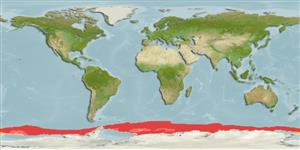>
Aulopiformes (Grinners) >
Anotopteridae (Daggertooth)
Etymology: Anotopterus: Greek, a = without + Greek, noton = back + Greek, pteron = fin (Ref. 45335).
More on author: Regan.
Environment: milieu / climate zone / depth range / distribution range
Écologie
marin bathypélagique; profondeur 0 - 2579 m (Ref. 36355). Deep-water; 55°S - 72°S
Southern Ocean: circumglobal (Ref. 31260). Collected from Meteor and Maud rises, in the Lazarev Sea, and near the South Sandwich Islands (Ref. 36355).
Taille / Poids / Âge
Maturity: Lm ? range ? - ? cm
Max length : 105 cm SL mâle / non sexé; (Ref. 31260); common length : 90.0 cm NG mâle / non sexé; (Ref. 5755)
Description synthétique
Morphologie | Morphométrie
Épines dorsales (Total): 0; Rayons mous dorsaux (Total): 0; Rayons mous anaux: 13 - 16; Vertèbres: 81 - 85. In adults, head depth 21.3-23.2% of lower jaw length; postorbital region 5.0-6.7% SL or 25.5-30% HL (1/3 of HL). Rear edge of gill cover overlaps with the vertical of the middle of the 4th vertebrae. Pectoral fins begin at the vertical of the end of the 4th to beginning of 5th vertebrae. Postadipose distance represents 4.6-5.9% SL (Ref. 31260).
Inhabits the epimesopelagic layer of the southern ocean circumglobally. Only fry and juveniles were observed in subtropical waters; large adults encountered in sub-Antarctic and Antarctic waters. Capable of shedding teeth and reducing gastrointestinal tract prior to spawning. Monocyclic, that is, they die after the first spawning (a reproductive strategy that evolved as a result of the large distance between feeding and spawning areas). Main food is
Notolepis coatsi which are 15-38 cm in length and weighs to 57-90 g (Ref. 31260).
Life cycle and mating behavior
Maturité | Reproduction | Frai | Œufs | Fécondité | Larves
Kukuev, E.I., 1998. Systematics and distribution in the world ocean of daggertooth fishes of the genus Anotopterus (Anotopteridae, Aulopiformes). J. Ichthyol. 38(9):716-729. (Ref. 31260)
Statut dans la liste rouge de l'IUCN (Ref. 130435)
Menace pour l'homme
Harmless
Utilisations par l'homme
Plus d'informations
Noms communsSynonymesMétabolismePrédateursÉcotoxicologieReproductionMaturitéFraiRassemblement de ponteFéconditéŒufsDéveloppement de l'œuf
Taille/ÂgeCroissanceLongueur-poidsLongueur-longueurFréquences de longueursMorphométrieMorphologieLarvesDynamique des populations larvairesRecrutementAbondanceBRUVS
RéférencesAquacultureProfil d'aquacultureSouchesGénétiqueElectrophoresesHéritabilitéPathologiesTraitementNutrientsMass conversion
CollaborateursImagesStamps, Coins Misc.SonsCiguateraVitesseType de nageSurface branchialeOtolithesCerveauxVision
Outils
Articles particuliers
Télécharger en XML
Sources Internet
Estimates based on models
Preferred temperature (Ref.
123201): -0.5 - 1.5, mean 0.7 °C (based on 292 cells).
Phylogenetic diversity index (Ref.
82804): PD
50 = 0.7500 [Uniqueness, from 0.5 = low to 2.0 = high].
Niveau trophique (Ref.
69278): 4.5 ±0.80 se; based on food items.
Résilience (Ref.
120179): Faible, temps minimum de doublement de population : 4,5 à 14 années (Assuming tmax>10).
Fishing Vulnerability (Ref.
59153): Very high vulnerability (77 of 100).
